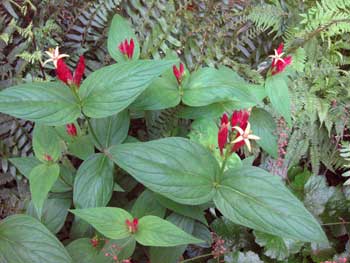Contents:
Common Names | Parts Usually Used | Plant(s) & Culture | Where Found | Medicinal Properties | Biochemical Information
Legends, Myths and Stories | Uses | Warning | Bibliography
Scientific Names

- Spigelia marilandica L.
- Loganiaceae
- Logania family
Common Names
- Carolina pink
- Indian pink
- Maryland pink
- Star bloom
- Worm grass
Parts Usually Used
Rootstock
Back to Top
Description of Plant(s) and Culture
A herbaceous perennial plant, grows 12-24 inches high. The small, fibrous, yellow rootstock produces a smooth, erect, purplish, tufted stem with opposite, sessile, entire, lanceolate leaves about 2-4 inches long. The club-shaped flowers are red on the outside and cream yellow on the inside (throats), growing in a short one-sided spike from May to July.
The blooming flower of pinkroot can be easily identified by its 5-lobed, trumpet-shaped flowers, which are scarlet on the outside and cream-yellow within.
Another herb: The Arapaho Indians used a plant called pink root (Horkelia Gordonii). They made a tea from the root and used it as a tonic. The root was dug just before maturity when the plant has sap.
Back to Top
Where Found
Native to the rich woodlands and open areas of the southeast United States, from New Jersey to Florida, Texas, eastern Oklahoma to Missouri, Indiana. Indigenous to America.
Back to Top
Medicinal Properties
Anthelmintic (destroys worms), narcotic.
Back to Top
Biochemical Information
Spigline, a poisonous alkaloid, tannin, resin, wax, fat, albumen, myricin, mucilage and a bitter principle.
Back to Top
Legends, Myths and Stories
The Cherokee Indians collected the herb for market in the northern part of Georgia, but since their removal, the supply now comes from the far south-west.
If the worms persist after treatment with this herb, it is suggested that another administration of the decoction be at full moon; the worms are more active at this time and more vulnerable to treatment.
Back to Top
Uses
The effectiveness of pinkroot against worms, tapeworms and roundworms, was known by the Native Americans, from whom its use was learned by the medical profession. Given in proper dosage and followed by a strong laxative, it was found to be highly effective for both children and adults. A decoction of the fresh rootstock was generally preferred, but the dried powdered rootstock was also commonly used. If the laxative salts (usually epsom salts (magnesium sulphate) is recommended) are not taken immediately after the herb, there can be toxic side-effects, including blurring vision, dizziness, spasms, and palpitations. In large doses there can be depression of both respiration and circulation and possible death from convulsions.
Back to Top
Warning
Non-poisonous to the body but should be used according to age and with other herbs.
Pinkroot may produce side-effects such as rapid heart-beat, dizziness, and sluggishness. An overdose can be fatal. Not recommended for use without medical supervision.
Back to Top
Bibliography
![]() The Herb Book
The Herb Book, by John Lust, Bantam Books, 666 Fifth Avenue, New York, NY. copyright 1974.
![]() Eastern/Central Medicinal Plants
Eastern/Central Medicinal Plants, by Steven Foster and James A. Duke., Houghton Mifflin Company, 215 Park Avenue South, New York, NY 10000
![]() Planetary Herbology
Planetary Herbology, by Michael Tierra, C.A., N.D., O.M.D., Lotus Press, PO Box 325, Twin Lakes. WI 53181., Copyright 1988, published 1992
![]() Indian Uses of Native Plants
Indian Uses of Native Plants, by Edith Van Allen Murphey, Meyerbooks, publisher, PO Box 427, Glenwood, Illinois 60425, copyright 1958, print 1990
![]() Indian Herbalogy of North America
Indian Herbalogy of North America, by Alma R. Hutchens, Shambala Publications, Inc., Horticultural Hall, 300 Massachusetts Avenue, Boston, Massachusetts 02115, 1973
![]() Webster’s New World Dictionary
Webster’s New World Dictionary, Third College Edition, Victoria Neufeldt, Editor in Chief, New World Dictionaries: A Division of Simon & Schuster, Inc., 15 Columbus Circle, New York, NY 10023
